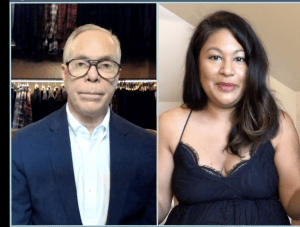Day 2 of Fast Company’s Festival of Innovation–Innovation for Good had me (and thousands of my close friends) hearing from Tommy Hilfiger, the fashion designer.
Tommy Hilfiger is on the left, an editor for Fast Company is on the right.
Tommy Hilfiger defines American style. The brand has worked on becoming more sustainable and innovative. The pandemic and BLM led them to think about how they operate, and they realized they needed to change their strategy.
Covid at first made them change to short term thinking, focusing on associate health and well being and cash flow. The brand then changed to midterm recovery: how do they get out of crisis and build back the business? Sustainability became even more important. The brand did not slow down investment in sustainability—now they are launching a new sustainability strategy.
In September, they announced their ‘make it possible’ strategy for the next ten years. Co-creation process with 100 of associates. Circularity and inclusivity: the brand wants to be a brand that wastes nothing and welcomes all. These two pillars will drive everything they do.
• They have many new styles using organic cotton, sustainable cotton, and low impact finishing techniques.
• Tommy For Life—resale market for used Tommy Hilfiger clothes
• Washing denim pollutes ocean and lakes and streams with poison as indigo dye goes into system and hangs around. They figured out a way to wash denim without water. The denim is broken down (softened and colored) with laser treatments!
• Use fewer chemicals, water and energy in manufacturing.
• On-demand manufacturing—the goal is to have no inventory.
• Using all solar power in their plant in the Netherlands.
• 3D digital design—designs are all done on computer, not wasting time, money, logistics, emissions, materials
Tommy believes that if his company takes the lead on this, other companies will follow.
They are also focused on creating an inclusive workspace and looking after workers’ rights. Workers will have stronger voices in the company. They are also reintroducing “People’s Place”, a platform that the brand will use to bring in BIPOC to mentor them and tap into the Hilfiger network and collaborate with them.
My take–this company says the right things. It has a history of being on the cutting edge, particularly in the digital space. They have made some strides to be more sustainable, and if they can keep up the momentum and show a profit they will be a market leader in sustainability. Cotton is always a problematic fabric, so we’ll see how the continued use of that fabric affects their sustainability.
I’m not as familiar with issues of diversity and inclusion in the fashion industry—my take was that this is one of the more diverse industries but I may be wrong. I’ll do a bit more digging on this aspect and watch to see how they build a better company in this area.
